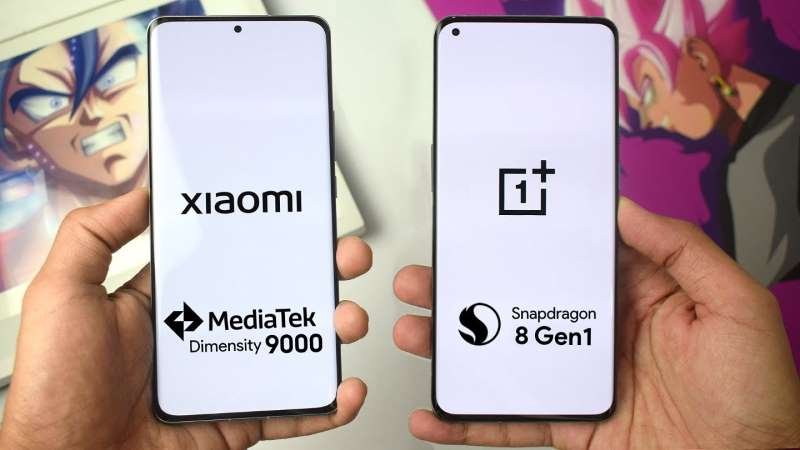Table of Contents
In the article, we’ll analyze the two chipsets, Dimensity 9000 and Snapdragon 8 Generation 1, released toward the closing of 2021. 2021 passed by very quickly. Snapdragon 808 and Dimensity 1200, as well as many other chipsets, have been released. Certain chipsets didn’t offer the best performance improvement over the prior generation. Keep reading for details comparison of Snapdragon 8 Gen 1 vs MediaTek Dimensity 9000.
If we consider Qualcomm’s Snapdragon 888, for instance, it didn’t offer substantial improvements over the prior generation Snapdragon 865. Furthermore, Snapdragon 865 performed better at certain points. ARM announced the ARM V9 architecture during the 2nd quarter of last year’s second quarter. Of course, new CPUs supporting the new architecture were introduced. Cortex-X2, Cortex-A710, and Cortex-A510.
These CPUs are significant enhancements to their previous models. The concept behind them was big core sizes and high power consumption to deliver more efficiency; cortex-x1, unfortunately, did not provide a significant performance boost in chipsets like Snapdragon 888 or Exynos 2100 Snapdragon 888 that was introduced in the last year. These SOCs are built on Samsung’s five nanometers (5LPE) manufacturing process. However, Samsung’s 5nm (5LPE) manufacturing method doesn’t provide the best performance or power efficiency.
Snapdragon 8 Gen 1 and Dimensity 9000 Specifications

Before proceeding with the Dimensity 9000 and Snapdragon 8Gen 1 comparability, we have first described the specific technical specs of both chipsets listed in this table. In this review, we will examine the chipsets more in-depth. The Dimensity 9000 chipset was launched by MediaTek in November 2021 to make the most significant difference from its counterparts. It includes the latest Cortex-X2, Cortex A710, and Cortex A510 CPUs also come with the Mali-G710 GPU with 10 cores.
It is important to note that TSMC comes with the top technology of 4nm (N4) production technology. Snapdragon 8 Gen 1, the successor of Snapdragon 8 Gen 1, Snapdragon 8 Gen 1, aims to be the best flagship chip with the new Adreno 730 GPU and its X65 5G Modem and other features. It’s important to understand that this chip is made using Samsung 4nm (4LPE) production technology, which is not as efficient as TSMC 4nm (N4) production technology. Now we’ll move on to our testing.
SD 8 Gen 1 vs Dimensity 9000: CPU
Both chipsets share similar CPU designs. Both feature 1+3+4 octa-core CPU designs. The choice of cores is similar between the two chipsets. There are some minor variations in frequency that favor that of the Dimensity 9000.
In a live test using the benchmark AnTuTu, the two chipsets scored over one million points. For instance Snapdragon 8 Gen 1 scored 1,035,020 points. Snapdragon 8 Gen 1 chip scored 1,035,020 marks, and the MediaTek Dimensity 9000 had 1,007,396 marks. Looking at the benchmark, it’s amazing to witness MediaTek getting on the same level as Snapdragon’s top product.
SD 8 Gen 1 vs Dimensity 9000: GPU
Concerning the GPU, both chipsets offer a variety of great capabilities to play games. As per Qualcomm, Snapdragon 8 Gen 1 GPU Snapdragon 8 Gen 1 GPU is 30 percent more efficient and draws the same amount of power as its predecessor. It is the most advanced GPU Qualcomm has made yet. This Arm Mali G710 GPU on Dimensity 9000 is 20 percent more efficient than the predecessor. It also has the latest raytracing SDK, which is open to developers who can bring the latest improvements to visuals. Its Dimensity 9000 features powerful GPUs that compete directly with Snapdragon 8 Gen 1 squarely. Snapdragon 8 Gen 1. is a square.
SD 8 Gen 1 vs Dimensity 9000: ISP
In terms of cameras’ sensor flexibility and innovation, both chipsets are equal. MediaTek’s 18-bit HDR ISP of MediaTek offers support for up to 320MP of sensor and is able to record video with up to 8k resolution. Furthermore, it is able to process up to 9 gigapixels per second. It is more than that of the ISP in Snapdragon 8Gen 1, which is able to process only 3.2 gigapixels in a second. Other features included in the Snapdragon 8 Gen 1’s ISP are impressive as well.
Its 18-bit HDR ISP built into Snapdragon 8 Generation 1 can shoot 8k video in HDR and electronically stabilized images. It’s remarkable. Additionally, it can take 120 photos with a resolution of 12MP within a second, and it has an engine that is specifically designed for 4K Bokeh recordings of video. Overall, both chipsets offer the top-of-the-line ISP, packed with features. We hope that tech companies benefit from it.
SD 8 Gen 1 vs Dimensity 9000: Memory
MediaTek Dimensity 9000 is ahead of the pack, as it’s the first processor that comes with LPDDR5X memory capabilities, whereas Snapdragon 8 Gen 1 maintains LPDDR5. The LPDDR5X standard developed for RAM is better than the LPDDR5. Furthermore, the LPDDR5X standard is more energy-efficient than LPDDR5.
SD 8 Gen 1 vs Dimensity 9000: Connectivity
The first mobile chip to have Bluetooth version 5.3 is the MediaTek Dimensity 9000. However, the Snapdragon 8Gen 1 is equipped with Bluetooth 5.2 support, and it is one generation ahead of the competition.
Snapdragon 8 Gen 1 is more powerful. It can support both Sub-6GHz and mmWave. It contrasts with other devices like the MediaTek Dimensity 9000, that supports only Sub-6GHz. The 5G-compatible modem X65 that is used to power Snapdragon 8 Generation 1 can be much faster as it can download up to 10Gbps.
SD 8 Gen 1 vs Dimensity 9000: ANTUTU Score
On AnTuTu, The Dimensity 9000 most popular running score is 1,007 470 points, and it is the Snapdragon 8 Gen 1 under the same conditions is 977,951 points. When used at ambient temperature, this performance update of Dimensity 9000 is superior to that of the Snapdragon 8.
Additionally, the most significant difference between these two chips lies in their manufacturing process. In addition, Dimensity 9000 uses the latest TSMC 4nm process. However, Snapdragon 8 Gen 1 Snapdragon 8Gen 1 uses Samsung’s foundry with 4nm. Even though the same process of 4nm is employed, the difference between the two processors isn’t huge. The real difference is evident in the heat generation and energy consumption sections.
Conclusion
Which one wins the battle of chipsets between the two? First, I want to congratulate MediaTek for creating a flagship chip that can contrast with the Snapdragon 8 Gen 1 without losing. Both chipsets are on par. I’m blown away by the fierce competition, as it is a good thing for consumers to have the best.
Also Read: Tesla Model Pi Smartphone: News, Price, Release Date, Specs, and Rumors

